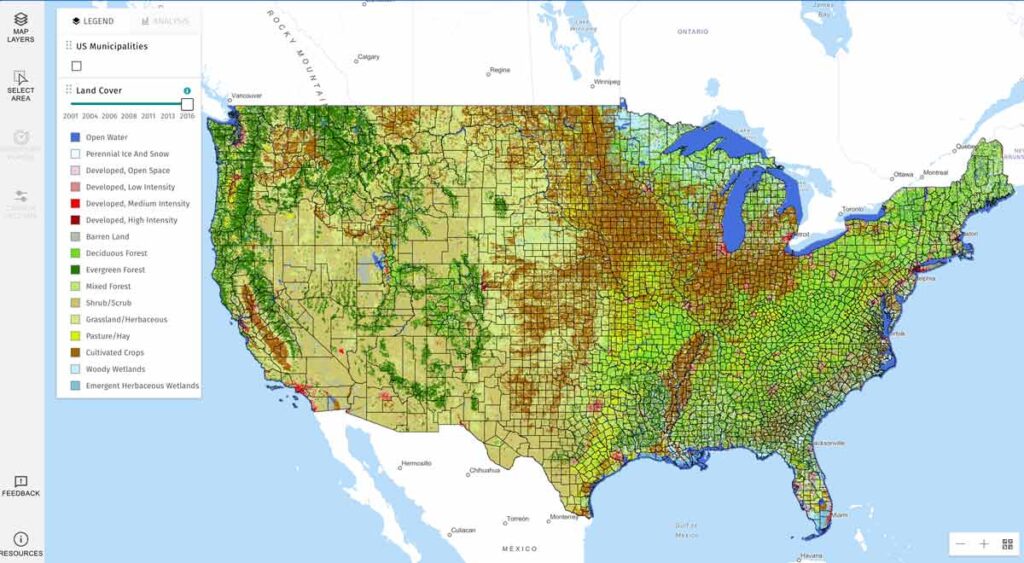Increasing carbon sequestration and reducing emissions from local forests and trees plays a key role in climate change mitigation. Land use, land-use change, and forestry resulted in a net offset of 12.3 percent of the United State’s total 2019 greenhouse gas (GHG) emissions. To better understand local GHGs from forests, communities can now use the Land Emissions and Removals Navigator (LEARN) tool. This tool provides information on land cover, including forest cover and change, and preliminary analysis on emissions and removals that communities may use to inform and integrate nature-based solutions in their climate action planning.
Within minutes, communities using the LEARN tool can develop a basic understanding of the GHG emissions and removals of their local forests and tree canopy. With this knowledge, they will be better equipped to implement localized nature-based solutions, such as protecting existing forests that remove carbon from the atmosphere and reducing the loss of forests, which results in emissions.
Get Data Quickly
Getting local forest emission and removal data takes five easy steps:
- Select or upload the community boundary
- Choose what years to analyze
- Select a city with a similar climate or location to set emission and removal factors
- Enter harvested wood data, if applicable
- Refine the analysis with local input from data generated by the tool, as needed
Once these steps are complete, LEARN produces a report with the first analysis of GHG emissions and removals, and net balance, from forests and tree canopy cover in the area. Communities that integrate data from forests into their GHG inventory will have a more complete understanding of their GHG emissions and removals.
See sample report for Boulder County, CO.
Note: The LEARN tool currently provides information on “trees outside forests” (e.g. urban trees, trees in grasslands, etc.) for 2011 and 2016, using NLCD Tree Canopy. However, we have found this data can significantly underestimate tree canopy, particularly in urban landscapes and recommend that cities, in particular, use iTREE canopy or another high-resolution dataset to estimate GHGs from trees.
LEARN in Action
Cindy Jayne, Chair of the Jefferson County / Port Townsend, Washington Climate Action Committee comments on her community’s use of the LEARN tool:
Jefferson County, Washington volunteers used the LEARN tool to learn how the net carbon sequestration of our trees has changed over the past 10 years and to establish a baseline for the future. The city/county Climate Action Committee plans to use their analysis to set a basis for future sequestration goal setting. The LEARN analysis complements our ongoing GHG emission tracking, especially since our county hosts a significant amount of state and national forestland.
The LEARN tool is quite easy to use for generating a first-cut estimate of carbon sequestration. To estimate the carbon stored in our forest products, we input state timber harvest data in the tool’s Harvested Wood Calculator. Also, the tool provided access to raw data that allowed us to correct differences in our data and the automated National Land Cover Database’s land cover change analysis.
Why LEARN is Needed
In 2019, ICLEI conducted a study where 60 percent of U.S. community respondents did not include forests or trees in their greenhouse gas inventories due to a lack of guidance on how to do so. To solve this problem, ICLEI developed the Forest and Land Use Appendix to ICLEI’s U.S. Community Protocol for Accounting and Reporting Greenhouse Gas Emissions in partnership with the Woods Hole Research Center and World Resource Institute (WRI), and funded by Climate and Land Use Alliance (CLUA) and Doris Duke Charitable Foundation. ICLEI and partners developed the LEARN tool in conjunction with this new appendix to support communities interested in understanding GHGs from forests. It uses the National Land Cover Database (NLCD) data for its analysis.
